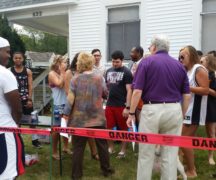By JAN LARSON McLAUGHLIN
BG Independent News
BGSU’s student retention rate slipped this fall, sending officials scrambling to find ways to help students stay at school.
It’s not enough for Bowling Green State University to attract new students to come to school. The university has to keep them coming back for more – until they graduate. That’s because universities in Ohio no longer get state funding per student headcounts. Now they get paid if students return to school each year and earn diplomas.
So the recent dip in returning students at BGSU was concerning Friday to the BGSU Board of Trustees. Last fall, the retention rate was 77.5 percent. This fall, the rate of returning students had dropped to 75.8 percent – creating a bigger gap between reality and the retention goal of 80 percent.
“Obviously, we’re not satisfied,” said BGSU Provost Rodney Rogers. “The goal is 80 percent, so we will continue to work on that.”
Retention rates dropped for on-campus students (78.4 to 76.5 percent) and for commuter students (67.9 to 64.7 percent.)
Meanwhile, several other universities in Ohio were meeting their goals of 80 percent or higher retention rates, Rogers said. Rates at Ohio University, Ohio State University, Miami University and Kent State were all higher than BGSU, while the University of Toledo’s rate was lower.
But Rogers assured that BGSU could achieve the higher rate. “That 80 percent is a very appropriate goal for us,” he said.
BGSU Trustees President David Levey questioned how the university would meet the goal. “Everybody’s focused on retention and our numbers are slipping,” he said. “What are we going to do this year?”
However, Trustee Dan Keller cautioned the board to not over-react to one slip in the retention rate. If the one-year blip turns into a trend, then it will be time to worry, he said.
Rogers and Tom Gibson, vice president of student affairs and vice provost, explained that several efforts are already underway to improve the rate.
“The two of them are taking this very, very seriously,” Keller said.
Among freshman, the highest risk groups for non-returning students are commuters, first-generation students, and Pell-eligible students.
“For each of these, we have strategies in place,” Rogers said. “We’re very much focused on these sub-populations.”
“We’re seeking to better understand their needs,” Gibson said.
Commuting students sometimes don’t feel fully engaged with the university. So advisers to these students are being made aware that they may need help finding ways to get involved on campus.
To Pell-eligible students, offering scholarship assistance may be key. “It tends to be a financial reason why they don’t return,” Rogers said.
And first-generation students may not be aware of the support systems available to them. “They’re most at risk,” he said.
Gibson listed several facilities, programs and supports that may help retain these and other students.
He pointed out the new $33 million Greek Village which houses 33 Greek groups. “Students who reside on campus retain at a better rate” and do better academically, Gibson said.
In an effort to teach students resiliency, the university offers Grit Week which focuses on mazes and building blocks that may be frustrating. “This would also encourage them to persist,” and increase the students’ ability to stick it out when school gets tough, Gibson said.
The university focuses on helping student make career decisions, offers academic peer mentors, and works to meet the needs of students with learning differences.
An “early alert system” is in place that allows faculty to notify the Learning Commons if they feel a student needs help – before the problem reaches a crisis level.
On the positive side, freshmen enrollment is up – and better prepared to succeed. The freshman class is up 4.6 percent from last fall, totaling 3,562. And their ACT scores show great promise.
“This is the largest, most academically prepared class,” BGSU has ever had, Rogers said.
To start the year off right, opening weekend events have been expanded to make freshmen feel welcome and engaged.
“We have a real opportunity to engage students and make them feel like they belong,” Gibson said. “Student engagement is the most critical” criteria for retention.
Hanging onto the freshman class is vital. “If we can retain them to the sophomore year, we do really well,” Rogers said. Overcoming the “sophomore slump,” can often be accomplished by helping uncertain students identify a major so they feel a connection with those sharing a common direction.





